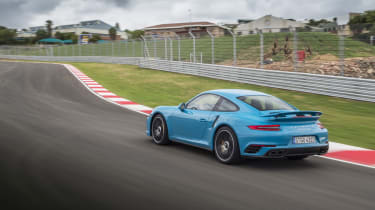991 Porsche 911 Turbo and Turbo S review (2012-2019) – engine and gearbox
The Porsche 911 Turbo still leads the way as a usable supercar
The familiar twin turbocharged 3.8-litre flat six remains from the first generation 991 Turbo, but modified inlet ports, new injection nozzles and higher fuel pressure – up from 140 bar to 200 bar – have helped liberate an extra 20bhp. Boost pressure has also risen by 0.15 bar and, for the first time, the S model uses different, bigger turbochargers from the basic Turbo model.
Peak power is up to 572bhp at 6750rpm for the Turbo S, meanwhile torque is a substantial 553lb ft between 2250 and 4000rpm. The Turbo makes do with ‘just’ 532bhp and 523lb ft of torque. To improve response, both new Turbos include a dynamic boost function that keeps the throttle valve open for 1.5-2 seconds after the driver has lifted off the throttle so the turbos don’t drop boost between throttle applications.
Both Turbo models are connected exclusively to Porsche’s all-wheel drive system and a 7-speed dual-clutch PDK gearbox. They also now have redesigned clutch plates in the all-wheel drive system ensuring even faster torque distribution between the front and rear axles, meanwhile the rear axle still features Porsche torque vectoring. Rear-wheel steer and Porsche active engine mounts are also correct and present.
Some worried about the relevance of the Turbo once the cooking 911 models were fitted with their all-new 3.0-litre flat-six turbo, but the difference between the models is thankfully more than just differing power figures. The Turbo has been developed to maintain that turbocharged feeling, with both variants having a more pronounced turbo rush in the mid range. Differences can be seen on the spec sheet, with the turbo models both producing maximum power relatively high in the rev range, while the standard 911 Carreras produce their maximum figure lower down.




